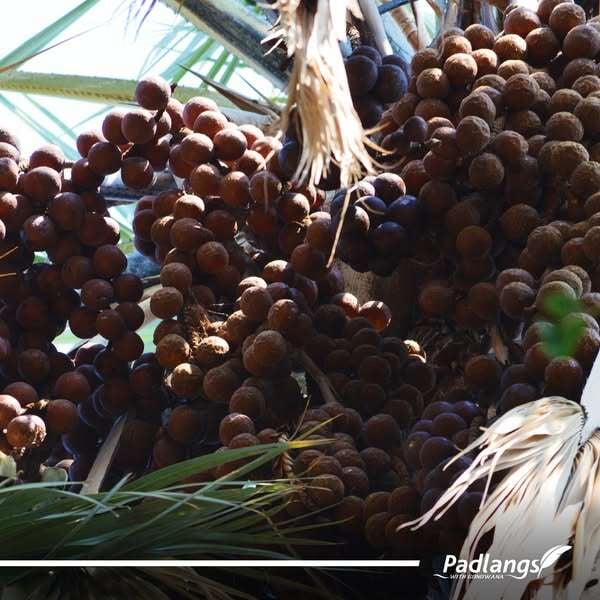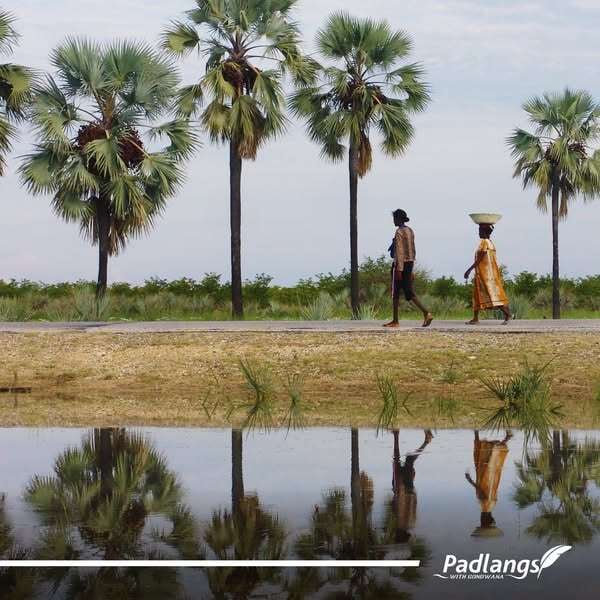The Omulunga, commonly also known as the makalani palm (Hyphaene petersiana), is without doubt one of the most iconic and useful trees of Owambo.
Clumps of these majestic trees are a characteristic feature of the oshana landscape of the western Oshikoto, Oshana and Omusati regions. They are especially eye-catching when their straight stems and clusters of fan-shaped leaves are etched against the sunset, creating postcard-pretty subjects for photographers.
The Omulunga usually grows as a single-stemmed tree, but twin- or multi-stemmed trees are not uncommon. The grey-brown stem reaches heights of up to eight metres or more and occasionally has a swelling in the middle or upper section. The fan-shaped leaves, which are up to two metres long, are clustered at the end of the branches, hence the Omulunga’s other popular common name, Fan Palm.
Male and female trees grow separately and a single female tree can produce up to 2,000 almost spherical reddish-brown fruit. The fruit takes up to two year to mature and another two years before they fall off.
The fruits are an important source of food for many rural families as they are usually collected around September and October when ombidi (wild spinach) and wild fruits are not yet available.

A stick is used to remove the hard outer shell and the fibrous pulp that surrounds the nut is eaten fresh. Its taste resembles ginger. The kernel of green fruit contains milk similar in taste and colour to coconut milk, while oil is extracted from the fruit of female trees.
The seed, which is covered by a dark brown layer, owes its name “vegetable ivory” to the hard ivory-coloured layer of the seed. It is used for carving souvenirs such as key rings, necklaces and other small ornaments. Young girls use twin fruits to make dolls, which they dress in traditional attire to depict the different stages in a young girl’s life. The dolls are carried around like babies by the girls.
The core of the young trunk is eaten as a vegetable, while the fruits are fermented for a few days and used for the distilling of ombike, commonly referred to as Owambo Gin.
The oluko (leaf stalks) are used as a stirring spoon when cooking omahangu, as well as to stir omalodu (a traditional beer made from sorghum malt). The leaf stalks are also used as fencing material where Omilunga (plural of Omulunga) are common and where Omusati trees are rare, while traditional fishing thrust baskets are made from the fronds. These baskets are made from Iizimba or bitter bush (Pechuel-Loesche luebnitziae) sticks and Omulunga leaves which are bound together with the bark of the Omushegela or raisin bush (Grewia spp.). The unopened leaves of oshivale (young trees) are harvested and used for the weaving of baskets, mats and hats. The leaf ends are boiled in water and dried in the sun, or boiled with the bark of the Omuye or bird plum (Berchemia discolour) which produces a reddish colour or the gwarrie bush (Euclea divinorum) which gives it a dark brown colour.
Dead trunks are cut into lengths of 2 to 2.5 metres and hollowed out for use as drinking troughs. The trunks are treated with old car oil to protect them against termites and are also used as traditional seats.
The Omulunga’s sap is tapped by making an incision near the growth tip reached by means of ladders made from hardwood or by knocking wooden pegs into the trunk. Leaf blades are inserted into the incision and the sap oozes down the leaf blades into containers. The fresh sap has a refreshing taste resembling ginger beer and is only slightly intoxicating. However, if the sap is fermented for 24 to 36 hours it produces a potent palm wine, locally known as ombike, also known as owalende.
Between 60 and 70 litres of sap can be harvested from a single tree, but continued harvesting can cause the trees to die. Although the practice has been forbidden, tapping still takes place. The sap is usually tapped from male trees, while female trees are left to grow and produce fruit.
The Omulunga is a truly remarkable and useful tree for the people of Owambo.



%20(1).png)
.jpg)
.jpg)




.png)

SUBMIT YOUR COMMENT